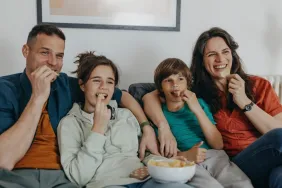Any parent can tell you: getting kids to eat well requires more than a repertoire of healthy, tasty recipes. Delicious food may be the vehicle, but good food parenting and a vibrant family food culture are the drivers.
How many times have you made something good-for-you and totally delicious—that you know your kids will like—only to have them refuse their meal? Too many to count? Join the club. This is inevitable, normal even. It’s developmentally appropriate for kids to flex their ‘I’m-in-charge-of-myself‘ muscles whenever possible, and mealtime is an easy time for this to play out. It’s also developmentally appropriate for us to let them know that, actually, we decide what the family eats.
Parenting is a huge—perhaps the biggest—part of teaching our children to eat in a way that is enjoyable and good for them. Modeling healthy eating habits, setting reasonable rules (believe me: your kids will not starve if you refuse to feed them anything other than what you’ve served for dinner), and giving appropriate opportunities for kids to help in the kitchen and make their own smart food decisions are among my key food parenting strategies. Then there is family food culture, your family’s way of thinking about and emotional connection to food that develops through everyday interactions with food.
While not everybody is aware of it, every family has a food culture that is either working with or against your parenting strategies. That’s right: with or against! It’s one way or the other, so why not align your food culture with your strategies towards the goal of healthier eating?
Start by identifying your family’s food culture.
- What kinds of conversations do you have about food and cooking?
- Where do you buy your food?
- Who cooks and are the kids around to help or watch?
- Do your kids help with grocery shopping or putting away groceries? What do they see?
- What kind of whole foods are your kids exposed to?
- Do they get opportunities to touch, taste and smell individual ingredients, as well as finished dishes?
- Does your family know where the food you eat comes from?
- How and when do you share meals?
- What does mealtime represent in your home?
- What foods do you eat regularly? What foods have special meaning to your family?
Answers to these questions provide insight into the food culture you’ve been shaping for your family, whether knowingly or not. The more positive awareness and conversation there is around healthy food, the more likely your parenting strategies will effectively encourage lasting healthy eating habits.
In parenting-101 we learn that, though they push against them, children thrive when they are given boundaries (parenting) and feel safe (family culture). Even adventurous children need familiar things and routines to anchor them, and it’s no different at mealtime. Suddenly serving quinoa or kale because you’ve learned that it’s healthy is not likely to work, no matter how delicious the recipe. But, if it feels safe because your children have heard the word kale, have read about it, have seen and felt it at the farmers market, well then, you just might be in luck.
Okay, maybe not right away, but the more exposure children get to healthy ingredients away from the pressures of mealtime, the more likely they are to be receptive. You know, eventually. (Did I mention patience and consistency are key parenting strategies, too?!)
One of many ways that you can enhance your family food culture is by reading books about food. I’m not suggesting that you and your seven-year-old start digging intoThe Ominvore’s Dilemma (unless, of course, you’ve got a very precocious and food interested seven-year-old). Rather, find age appropriate books that mention food, cooking, gardens; that show pictures of food; that show families sharing mealtime. The content doesn’t have to be formal “education about food” as much as bring our connection to food to the forefront.
There are tons of great food books for children. Here is a starter list for little ones, to which I hope you’ll add.
What are your favorite children’s books about food?
First Books
- Pancakes, Pancakes by Eric Carle
- Eating the Alphabet by Lois Ehlert
- Jamberry by Bruce Degen
- I Eat Fruit! (and other books in the Things I Eat Series) by Hannah Tofts
Toddler and Preschool
- Yum Yum Dim Sum (and other books in the World Snacks series) by Amy Wilson Sanger
- The Carrot Seed by Ruth Krauss
- Bee-bim Bop! by Linda Sue Park
- Pretend Soup and Other Real Recipes by Mollie Katzen
- An Egg is Quiet and A Seed is Sleepy by Dianna Hutts Aston
- How My Parents Learned to Eat by Ina Friedman
- Pete’s A Pizza by William Steig
- Blueberries for Sal by Robert McCloskey
Five- to Eight-Years-Old
- Who Eats What? by Patricia Lauber
- Stone Soup by Marcia Brown
- In the Night Kitchen by Maurice Sendak
- Everybody Bakes Bread by Norah Dooley
- Where Does Food Come From? by Gary Goss
- How to Make an Apple Pie and See the World by Marjorie Priceman
- I Will Not Ever Never Eat a Tomato by Lauren Child
- The Tortilla Factory by Gary Paulsen
- Let’s Eat: What Children Eat Around the World by Beatrice Hollyer
You can link to these and other food books for children on Amazon through the One Hungry Mama affiliate store. You can also read more about family food culture at Simple Bites, where chef and food editor Amiee Wimbush-Bourque has written several great pieces on family food culture, including an article with her own book suggestions and, if you want to get heady, check out the resource page for the PBS series The Meaning of Food.








